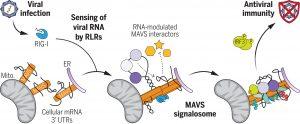A recent study has revealed a new function for cellular RNA in regulating immune responses to RNA viruses, shedding light on how cells fend off infections. Research uncovers how specific RNA molecules within cells enhance antiviral signaling by influencing the mitochondrial antiviral signaling (MAVS) pathway. These findings not only deepen our understanding of immune regulation but also open the door to RNA-based therapies for infections and autoimmune diseases.

Figure 1: RNA regulatory control of the MAVS signalosome. The adaptor protein MAVS binds to the 3′UTRs of cellular mRNAs through its central disordered region. After sensing of viral RNA by RLRs, cellular RNA promotes antiviral signaling through the MAVS signalosome by altering MAVS association with RNA-modulated MAVS-interacting factors. Mito., mitochondria; ER, endoplasmic reticulum.
The MAVS protein, located on the outer membrane of mitochondria, is a critical player in the immune system’s response to RNA viruses. When sentinel proteins within cells detect viral RNA, they activate MAVS, triggering the assembly of large molecular complexes known as signalosomes. These MAVS signalosomes act as platforms for protein-protein interactions, which amplify immune signalling and activate interferons and other antiviral defences.
While protein-protein interactions have long been recognized as central to MAVS activity, the study highlights the critical role of cellular RNA in this process. The research demonstrates that specific host RNA molecules bind directly to MAVS, enhancing the formation and function of the MAVS signalosome.
The study revealed that MAVS interacts with cellular RNA through a disordered region of the protein. These RNA-protein interactions help to fine-tune the immune response, maximizing the antiviral defence while avoiding excessive activation that could damage tissues or trigger autoimmune diseases.
The immune system requires a delicate balance: it must be strong enough to eliminate viral threats but not so aggressive that it harms the body. Dysregulated interferon pathways have been implicated in autoimmune conditions such as lupus. This study provides new insights into how cellular RNA contributes to maintaining this balance by modulating MAVS activity.
Their findings suggest that cellular RNA not only strengthens MAVS-mediated immune responses but may also regulate other immune signalling protein complexes. This discovery expands the understanding of RNA’s role in immune system regulation and highlights the potential for RNA to influence other critical protein-protein interactions in immunity.
The study highlights the potential for RNA-based therapeutics to treat infections and autoimmune diseases. With RNA increasingly recognized as both a drug and a druggable target, this research provides a framework for developing interventions that harness or modulate RNA’s role in immune signalling. Such therapies could improve antiviral defences or address conditions where immune responses become overactive.
Journal article: Nandan S. Gokhale, N.S., et al., 2024. Cellular RNA interacts with MAVS to promote antiviral signaling. Science.
Summary by Stefan Botha










